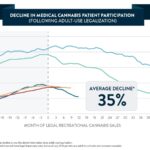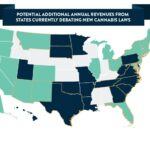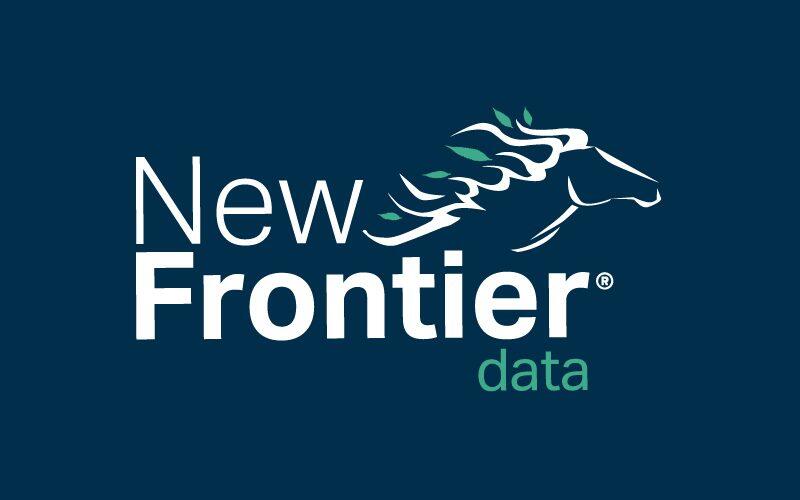Short of Federal Reform, Medical Cannabis Patients and Investors Need to Think Long to Remain Healthy in Patchworked Markets

Decline in Medical Cannabis Patient Participation
July 28, 2019
Potential Additional Annual Revenues From States Currently Debating New Cannabis Laws
August 4, 2019By J.J. McCoy, Senior Managing Editor, New Frontier Data
Medical cannabis patients tend to have enough concerns as it is, before any aggravation about the peculiarities of their particular state programs. Yet, it is an unavoidable condition for most patients and investors that they keep current with the patchwork of state policies and politics which characterize today’s markets pending federal reform.
After review earlier this month of how state medical cannabis markets vary in their saturation levels, analysis of data collected across legalized medical-cannabis markets nationwide shows that numbers of participating patients drop significantly wherever adult-use products are legalized for purchase (even among neighbors). The dynamic holds despite varying saturation rates based on length of operation (e.g., longer-established programs in Colorado and Oregon saw patient saturation rates reach about 2x that of newer, shorter-operated programs in Massachusetts, Nevada, and Vermont).
Divergence in program regulations lead to different outcomes state to state, but since a decline in a medical market occurs whenever an adult-use market opens, it is incumbent upon license-holders (whether of prescriptions cards or business licenses) to understand the political dynamics and trends within their respective states regarding any potential or pending adoption of full-use programs.
How will a recreational market affect medical-use participants? What amount of supply capacity will be required to efficiently fulfill demand? Since success in both medical and adult-use markets depends on the conditions to participate or adapt there is a premium on flexibility: Modularity in approach is required for agility amid uncertainty.
That holds true for operators as well as regulators. In one business-case example, a cultivation client was looking to build a $20 million facility before a board member presciently asked for clarity about what position they might find themselves in a few years later, once its state’s full-use program was to be activated. Upon further review, the investment call was delayed until new plans were developed to ensure they could efficiently scale into the capacity needed to supply the much larger adult use market, without needed to make significant new infrastructure investments at that time…
As illustrated in Michigan this month, each state has developed unique regulatory structures for medical and adult-use sales, with various ranges of incentives for registered medical cannabis patients to remain in its programs. Such differences include (but are not limited to) taxes affecting point-of-sale prices, costs of medical card renewals and doctor’s visits, availability of products across markets, and possession and purchase limits for patients and adult consumers.
Michigan officials have devised a new license type for large-scale cultivators to operate in both the medical and adult-use markets, by allowing the growers to have more plants than previously capped under state law. The state will also allow both medical and adult-use products to be sold in the same retail stores, provided that the products are distinctly separated. Likewise, should the state’s Marijuana Regulatory Agency deem conditions necessary, it has authority to temporarily allow for transfer of medical cannabis to the recreational market.
Conversely in some other states, though medical marijuana products often provide a higher THC potency, the prevalence and product choices of adult-use retailers offer some compelling incentives to avoid registering as a patient and instead shop directly to self-medicate. For their part, Illinois regulators have made provisions for dispensaries in that state’s forthcoming adult-use program to prioritize medical patients in case of any cannabis supply shortage after recreational sales begin on January 1, 2020.
With only one-third of medical states having passed adult use measures, the license holders in current and future adult use markets must prepare for the significant impact of adult use legalization. This will require an acute understanding of the local political and regulatory dynamics, a keen analysis of the consumer environment, including insights into what drives patients into the medical and adult use programs respectively, and a strong agile team that can respond effectively to each market’s organic evolution.




